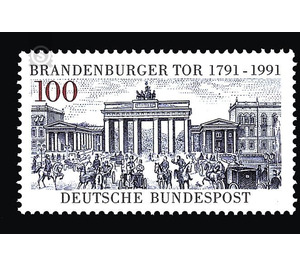200 years Brandenburg Gate - Germany / Federal Republic of Germany 1991 - 100 Pfennig
Theme: Architecture
| Country | Germany / Federal Republic of Germany |
| Issue Date | 1991 |
| Face Value | 100.00 |
| Color | black grey |
| Perforation | K 14 |
| Printing Type | combined intaglio and offset printing |
| Stamp Type | Postage stamp |
| Item Type | Stamp |
| Chronological Issue Number | 1365 |
| Chronological Chapter | GER-BRD |
| SID | 293380 |
| In 56 Wishlists | |
The Brandenburg Gate has been preserved as the only one of the original fourteen Berlin city gates. Between 1788 and 1791, shortly before and after the French Revolution, it was built by Carl Gotthard Langhans on the Quarré, the western end of Unter den Linden, on the site of an older gate. The appearance of this predecessor gate has been preserved for posterity through an etching by Daniel Chodowiecki. The Langhans built construction is made of sandstone. It is modeled on the "Propylaea" in Athens and thus documents the first monumental structure of Berlin Classicism. Six pairs of Doric columns, connected by walls, form a total of five passages, which are joined on the right and left two low, also surrounded by columns buildings that served the guard and the customs authorities as a domicile. At the gate is the five-meter-high quadriga with the goddess of victory designed by Johann Gotttried Schadow and floated in copper by Emanuel Jury in 1793. This symbol of Berlin was abducted by Napoleon to Paris in 1807; his return in 1814 was like a triumph. Since then, the Quadriga has been considered a symbol of victory in the wars of liberation. In 1791, the Brandenburg Gate was given the name "Friedensstor", the goddess of victory was interpreted as a "peace-maker". In the years that followed it was repeatedly deviated from this spirit by using, after victorious campaigns, Tor and Quadriga as a "stage" for triumphal marches. No one less than Karl Friedrich Schinkel had festively decorated the gate when Friedrich Wilhelm III. for the celebration of the Second Paris Peace in October 1815 with his troops to Berlin. Similar victory celebrations took place after the German-Danish War in December 1864 and after the Franco-Prussian War of 1871. Even at the outbreak of the First World War, Wilhelm II had himself celebrated at the Brandenburg Gate. At the end of this war it was no longer the Emperor, but the chairman of the Council of People's Deputies, Friedrich Ebert, who received the first Guardsmen of the defeated field army there with the words: "No enemy has overcome you! Now Germany's unity is in your hands! "But the revolutionary troops of 1918 also used the symbolism of the Brandenburg Gate, as did the roving brigades of Kapp, Lüttwitz, and Ehrhardt. On January 30, 1933, Hitler's SA marched in the firelight of the torches from the Great Star to the Reichskanzlerpalais to celebrate the seizure of power by the Nazis. In 1945, the victorious Soviet troops moved through the Brandenburg Gate to Berlin and erected their Victory Monument in its immediate vicinity. But not only military parades moved through the gate. Many state guests have been solemnly received here: it served as the ceremonial gateway to the city. In World War II Tor and Quadriga have been badly damaged. The gate was restored in 1956/1957, until 1958, after the preserved plaster cast of the original wooden model in a West Berlin foundry and the Quadriga was rebuilt in 1959 and handed over to the East Berlin authorities, the Prussian eagle and designed by Schinkel Removed iron cross. Tor and Quadriga were restored for the bicentennial celebration, which also received their attributes "eagle" and "cross" back. After the Second World War, the Brandenburg Gate stood as a symbol of "unity" and "freedom." On June 17, 1953, the insurgents in the GDR caught up with the red flag waving on the gate and replaced it for several days by the black-red-golden flag. When the Brandenburg Gate was "closed" with the action of the Berlin Wall in 1961, the division of the German capital and the entire country was not only visible in real terms. The gate symbolized the character of the divided city: Standing on East Berlin territory and provided with a restricted zone, it was accessible to both West and East Berliners only in sight. "Open the door!" Was the motto used to demand free movement and freedom for the Germans in the GDR. It was not until December 1989 that this goal was achieved, when, after the revolutionary events of October / November, politicians from East and West opened the Brandenburg Gate to the public at a festive event. On the following New Year's Eve, the Berlin and many foreign guests celebrated the restored unity of Berlin, on 3 October 1990, the Brandenburg Gate was the center of a folk festival on the occasion of the reunited unit of Germany. (Text: University Professor Dr. Wolfgang Ribbe)


